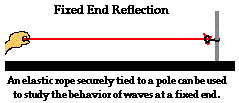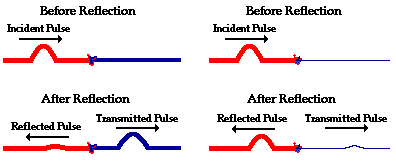Hold down the T key for 3 seconds to activate the audio accessibility mode, at which point you can click the K key to pause and resume audio. Useful for the Check Your Understanding and See Answers.
As a sound wave travels through a medium, it will often reach the end of the medium and encounter an obstacle or perhaps another medium through which it could travel. When one medium ends, another medium begins; the interface of the two media is referred to as the boundary and the behavior of a wave at that boundary is described as its boundary behavior. The behavior of a wave (or pulse) upon reaching the end of a medium is referred to as boundary behavior. There are essentially four possible behaviors that a wave could exhibit at a boundary: reflection (the bouncing off of the boundary), diffraction (the bending around the obstacle without crossing over the boundary), transmission (the crossing of the boundary into the new material or obstacle), and refraction (occurs along with transmission and is characterized by the subsequent change in speed and direction). In this part of Lesson 3, the focus will be upon the reflection behavior of sound waves. Later in Lesson 3, diffraction, transmission, and refraction will be discussed in more detail.
In Unit 10 of The Physics Classroom, the boundary behavior of a pulse on a rope was discussed.  In that unit, it was mentioned that there are two types of reflection for waves on ropes: fixed end reflection and free end reflection. A pulse moving through a rope will eventually reach its end. Upon reaching the end of the medium, two things occur:
In that unit, it was mentioned that there are two types of reflection for waves on ropes: fixed end reflection and free end reflection. A pulse moving through a rope will eventually reach its end. Upon reaching the end of the medium, two things occur:
- A portion of the energy carried by the pulse is reflected and returns towards the left end of the rope. The disturbance that returns to the left is known as the reflected pulse.
- A portion of the energy carried by the pulse is transmitted into the new medium. If the rope is attached to a pole (as shown at the right), the pole will receive some of the energy and begin to vibrate. If the rope is not attached to a pole but rather resting on the ground, then a portion of the energy is transmitted into the air (the new medium), causing slight disturbances of the air particles.
The amount of energy that becomes reflected is dependent upon the dissimilarity of the two media. The more similar that the two media on each side of the boundary are, the less reflection that occurs and the more transmission that occurs. Conversely, the less similar that the two media on each side of the boundary are, the more reflection that occurs and the less transmission that occurs. So if a heavy rope is attached to a light rope (two very dissimilar media), little transmission and mostly reflection occurs. And if a heavy rope is attached to another heavy rope (two very similar media), little reflection and mostly transmission occurs.

The more similar the medium, the more transmission that occurs.

These principles of reflection can be applied to sound waves. Though a sound wave does not consist of crests and troughs, they do consist of compressions and rarefactions. If a sound wave is traveling through a cylindrical tube, it will eventually come to the end of the tube. The end of the tube represents a boundary between the enclosed air in the tube and the expanse of air outside of the tube. Upon reaching the end of the tube, the sound wave will undergo partial reflection and partial transmission. That is, a portion of the energy carried by the sound wave will pass across the boundary and out of the tube (transmission) and a portion of the energy carried by the sound wave will reflect off the boundary, remain in the tube and travel in the opposite direction (reflection). The reflected pulse off the end of the tube can then interfere with any subsequent incident pulses that are traveling in the opposite direction. If the disturbances within the tube are the result of perpetual waves of a constant frequency, then interference between the incident and reflected waves will occur along the length of the tube. The reflection behavior of sound waves and the subsequent interference that occurs will become important in Lesson 5 during the discussion of musical instruments. Many musical instruments operate as the result of sound waves traveling back and forth inside of "tubes" or air columns.
The reflection of sound also becomes important to the design of concert halls and auditoriums. The acoustics of sound must be considered in the design of such buildings. The most important considerations include destructive interference and reverberations, both of which are the result of reflections of sound off the walls and ceilings. Designers attempt to reduce the severity of these problems by using building materials that reduce the amount of reflection and enhance the amount of transmission (or absorption) into the walls and ceilings. The most reflective materials are those that are smooth and hard; such materials are very dissimilar to air and thus reduce the amount of transmission and increase the amount of reflection. The best materials to use in the design of concert halls and auditoriums are those materials that are soft. For this reason, fiberglass and acoustic tile are used in such buildings rather than cement and brick.